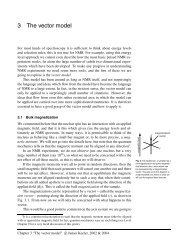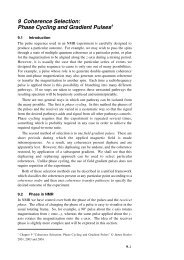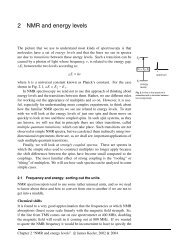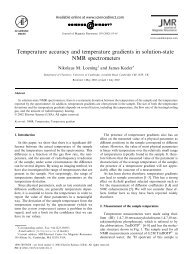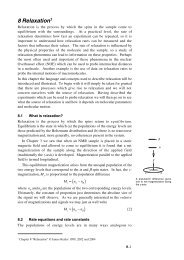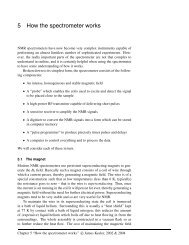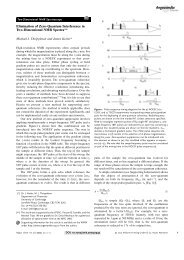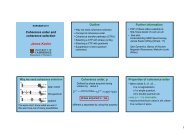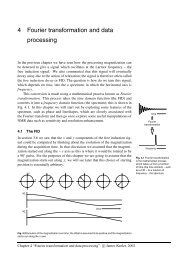Chapter 6: Product operators - The James Keeler Group
Chapter 6: Product operators - The James Keeler Group
Chapter 6: Product operators - The James Keeler Group
- No tags were found...
Create successful ePaper yourself
Turn your PDF publications into a flip-book with our unique Google optimized e-Paper software.
with respect to x". Its effect on the function sin x isd( sin x)=cos xdxthe "new function" is cos x. Operators can also be simple functions, so forexample the operator x 2 just means "multiply by x 2 ".A mass going round a circularpath possesses angularmoment, represented by avector which pointsperpendicular to the plane ofrotation.p6.1.1 Spin <strong>operators</strong>A mass going round a circular path (an orbit) possesses angular momentum; itturns out that this is a vector quantity which points in a direction perpendicular tothe plane of the rotation. <strong>The</strong> x-, y- and z-components of this vector can bespecified, and these are the angular momenta in the x-, y- and z-directions. Inquantum mechanics, there are <strong>operators</strong> which represent these three componentsof the angular momentum.Nuclear spins also have angular momentum associated with them – calledspin angular momentum. <strong>The</strong> three components of this spin angularmomentum (along x, y and z) are represented by the <strong>operators</strong> Ix, Iy and Iz.6.1.2 Hamiltonians<strong>The</strong> Hamiltonian, H, is the special name given to the operator for the energy ofthe system. This operator is exceptionally important as its eigenvalues andeigenfunctions are the "energy levels" of the system, and it is transitions betweenthese energy levels which are detected in spectroscopy. To understand thespectrum, therefore, it is necessary to have a knowledge of the energy levels andthis in turn requires a knowledge of the Hamiltonian operator.In NMR, the Hamiltonian is seen as having a more subtle effect than simplydetermining the energy levels. This comes about because the Hamiltonian alsoaffects how the spin system evolves in time. By altering the Hamiltonian thetime evolution of the spins can be manipulated and it is precisely this that lies atthe heart of multiple-pulse NMR.<strong>The</strong> precise mathematical form of the Hamiltonian is found by first writingdown an expression for the energy of the system using classical mechanics andthen "translating" this into quantum mechanical form according to a set of rules.In this chapter the form of the relevant Hamiltonians will simply be stated ratherthan derived.In NMR the Hamiltonian changes depending on the experimental situation.<strong>The</strong>re is one Hamiltonian for the spin or spins in the presence of the appliedmagnetic field, but this Hamiltonian changes when a radio-frequency pulse isapplied.6.2 Operators for one spin6.2.1 OperatorsIn quantum mechanics <strong>operators</strong> represent observable quantities, such anenergy, angular momentum and magnetization. For a single spin-half, the x- y-6–2



